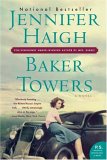Summary | Excerpt | Reading Guide | Reviews | Readalikes | Genres & Themes | Author Bio

Chapter One
Softly the snow falls.
In the blue morning light a train winds through the hills. The engine pulls a
passenger car, brightly lit. Then a dozen blind coal cars, rumbling dark.
Six mornings a week the train runs westward from
Altoona to Pittsburgh, a distance of a hundred miles. The route is indirect,
tortuous; the earth is buckled, swollen with what lies beneath. Here and there,
the lights of a town: rows of company houses, narrow and square; a main street
of commercial buildings, quickly and cheaply built. Brakes screech; the train
huffs to a stop. Cars are added. In the passenger compartment, a soldier on
furlough clasps his duffel bag, shivers and waits. The whistle blows. Wheezing,
the engine leaves the station, slowed by the extra tons of coal.
The train crosses an iron bridge, the black water
of the Susquehanna. Lights cluster in the next valley. The town, Bakerton, is
already awake. Coal cars thunder down the mountain. The valley is filled with
sound.
The valley is deep and sharply featured. Church
steeples and mine tipples grow inside it like crystals. At bottom is the town’s
most famous landmark, known locally as the Towers, two looming piles of mine
waste. They are forty feet high and growing, graceful slopes of loose coal and
sulfurous dirt. The Towers give off an odor like struck matches. On windy days
they glow soft orange, like the embers of a campfire. Scrap coal, spontaneously
combusting; a million bits of coal bursting into flame.
Bakerton is Saxon County’s boomtown. Like the
Towers, it is alive with coal. A life that started in the 1880s, when two
English brothers, Chester and Elias Baker, broke ground on Baker One. Attracted
by handbills, immigrants came: English and Irish, then Italians and Hungarians;
then Poles and Slovaks and Ukrainians and Croats, the "Slavish," as
they were collectively known. With each new wave the town shifted to make room.
Another church was constructed. A new cluster of company houses appeared at the
edge of town. The work—mine work—was backbreaking, dangerous and bleak; but
at Baker Brothers the union was tolerated. By the standards of the time the pay
was generous, the housing affordable and clean.
The mines were not named for Bakerton; Bakerton
was named for the mines. This is an important distinction. It explains the order
of things.
Chester Baker was the town’s first mayor.
During his term Bakerton acquired the first streetcar line in the county, the
first public water supply. Its electric street lamps were purchased from Baker’s
own pocket. Figure the cost of maintaining them for fifty years, he
wrote to the town bosses, and I will pay you the sum in advance. After
twenty years Baker ceded his office, but the bosses continued to meet at his
house, a rambling yellow-brick mansion on Indian Hill. A hospital was built, the
construction crew paid from a fund Baker had established. He wouldn’t let the
building be named for him. At his direction, it was called Miners’ Hospital.
The hospital was constructed in brick; so were
the stores, the dress factory, the churches, the grammar school. After the
Commercial Hotel burned to the ground in 1909, an ordinance was passed, urging
merchants to "make every effort to fabricate their establishments of
brick." To a traveler arriving on the morning train—by now an expert on
Pennsylvania coal towns—the hat shop and dry-goods store, the pharmacy and
mercantile, seem built to last. Their brick facades suggest order, prosperity,
permanence.
ON THE SEVENTEENTH of January 1944, a motorcar
idled at the railroad crossing, waiting for the train to pass. In the passenger
seat was an elderly undertaker of Sicilian descent, named Antonio Bernardi. At
the wheel was his great-nephew Gennaro, a handsome, curly-haired youth known in
the pool halls as Jerry. Between them sat a blond-haired boy of eight. The car,
a black Packard, had been waxed that morning. The old man peered anxiously
through the windshield, at the snowflakes melting on the hood.
The foregoing is excerpted from Baker Towers by Jennifer Haigh. All rights reserved. No part of this book may be used or reproduced without written permission from HarperCollins Publishers, 10 East 53rd Street , New York , NY 10022
The less we know, the longer our explanations.
Click Here to find out who said this, as well as discovering other famous literary quotes!
Your guide toexceptional books
BookBrowse seeks out and recommends the best in contemporary fiction and nonfiction—books that not only engage and entertain but also deepen our understanding of ourselves and the world around us.